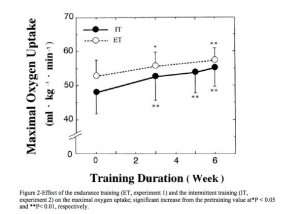
I noticed recently that "Tabata has gone mainstream".
Lyle MacDonald has an excellent piece de-constructing the (in)famous study behind the protocol.

Worth the read for sure.
High-intensity interval training and the Tabata protocol specifically are one tool in the toolbox but anybody proclaiming that intervals can do everything that anyone ever needs to do is cracked. That’s on top of the fact that 99% of people who claim to be doing ‘Tabatas’ aren’t doing anything of the sort.
Because 8 sets of 20″ hard/10″ easy is NOT the Tabata protocol and body-weight stuff or the other stuff that is often suggested simply cannot achieve the workload of 170% VO2 max that this study used. It may be challenging and such but the Tabata protocol it ain’t.

4 comments:
This is very true. So many people do 20seconds on, 10 seconds off and call it tabata.
Tabata is 100% absolute max effort. If you pace yourself, it simply isn't tabata, and though it may be good, the benefits won't be the same.
i think lyle is quoting posts i've been writing on forums for the past 5 years :)
except he missed one thing after 170%:
cadence is also critical in the protocol in order to get the profusion required too. hence using a cycle.
mc
Let's not get too negative on intervals as a whole though. They are still very time efficient for the benefits they provide.
The whole Tabata thing is way over the top but interval training does work and can deliver big benefits in a fairly limited time.
One thing I'm surprised is left out of this discussion is why Dr. Tabata studied this protocol.
As I understand it, Dr. Tabata was working with the Japanese speed skating team in the 1990's, who are well respected for setting a number of world records.
Anyways, the head coach is reported to have regularly used a grueling workout that consisted of the well known 8 sets of 20 second full speed sprints on skates, with 10 seconds rest.
Sprinting on skates, or simply your feet, is a very different workout than tabata squats/bike/thrusters/etc. The increased cross sectional muscle fiber area and motor unit activation probably induces a significantly different post workout super compensation cascade.
Post a Comment